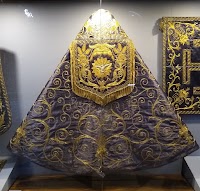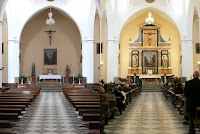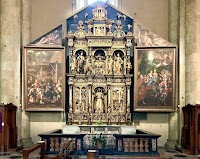 Our friend and colleague in liturgical studies, Nicola de Grandi, has recently sent in a few examples of some beautiful vestments, each made of velvet. Let's take a look at them. The first is a chasuble found in the cathedral of Aosta, Italy. The velvet is of later vinta…
Our friend and colleague in liturgical studies, Nicola de Grandi, has recently sent in a few examples of some beautiful vestments, each made of velvet. Let's take a look at them. The first is a chasuble found in the cathedral of Aosta, Italy. The velvet is of later vinta…
Our Advertising Partners
-
The global pandemic has disrupted the normal celebration of the Holy Week in Spain, where, for a second year, the government has forbidden t...
-
To the person who simply enjoys beautiful art and architecture, distinctions like "baroque" or "rococo" might seem overl...
-
We live in a very visual, image-based culture and, what's more, there is always lots of curiosity around the matter of traditional papal...
-
The earliest pictorial representations of the Baptism of the Lord were carved in stone, on Christian sarcophagi. Later, during the long Mid...
-
The mitre is one of the most recognizable symbols of prelates of the Church, specifically of bishops up to the Roman pontiff himself -- thou...
-
In a previous article we considered what the exterior of Old St. Peter's was like and today we will turn our attention to the interio...
Blog Archive
-
▼
2021
(258)
-
▼
September
(22)
- Three Vestments of Velvet from Italy
- Customs of Michaelmas
- Renaissance Art Flourishes at St. Thomas Aquinas i...
- Quatuor Tempora: Notes on Origin and Meaning of Em...
- The Tree of Jesse Ceiling of Michaeliskirche in Hi...
- Lessons on Customs and Traditions Seen in St. Wenc...
- Vestments from the Cathedral of Seville
- The 1758 Cope of San Juan de Dios, Granada
- Patrons of the Arts: Pope Urban VIII (1568-1644)
- The Miraculous Eleventh Century Plague Crucifix of...
- The Pax (Osculatorium or Tabula Pacis)
- Benjamin West's Woman of the Apocalypse and the Wi...
- A Brief Consideration of Two Blessed Sacrament Cha...
- Paris and Lyon: Orphrey Variations in French Vestm...
- The Stonyhurst Vestments: Catholic Vestments of Tu...
- The Ossuary Chapel of San Martino della Battaglia
- Before and After: St. Augustine's in Granada, Spain
- A Brief Survey of Some New Vestment Work
- Some Impressive Monumental Lipsanotheca and Relic ...
- The Neapolitan Reliquaries of Fra Diego da Careri ...
- Before and After: Our Lady of the Rosary in San Diego
- An Early 16th Century Masterpiece of Woodcarving: ...
-
▼
September
(22)
Donate
Copyright ©
Liturgical Arts Journal | Powered by Blogger






































